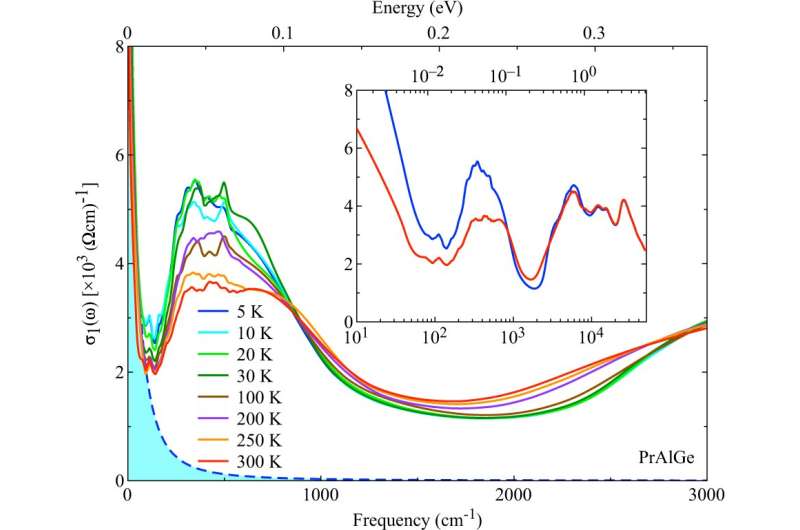The charge dynamics of a non-centrosymmetric magnetic Weyl semimetal

In work published in npj Quantum Materials, a team led by Prof. Leonardo Degiorgi in the Department of Physics at ETH Zurich has studied the broadband charge dynamics (i.e., longitudinal optical conductivity) of the ferromagnetic (FM), non-centrosymmmetric PrAlGe material. They reveal its electronic environment, based on correlated Weyl states, which favors an unusually large anomalous Hall conductivity (AHC) at low temperatures. The researchers thus propose a suitable experimental approach to trace the relevant ingredients of the electronic structure deploying substantial Berry curvatures, indispensable for AHC.
The family of the noncentrosymmetric RAlGe (R = rare-earth) materials is a suitable arena in order to advance our knowledge on novel topological states, which cover all varieties of Weyl semimetals, including type I, type II, inversion and time-reversal breaking symmetry, depending on the choice of the rare-earth element. PrAlGe is of particular relevance, since it breaks both the space-inversion and time-reversal symmetry, leading to the formation of pairs of type I Weyl nodes.
The work presents measurements of the optical reflectivity, collected from the far infrared (FIR) to the ultraviolet at nearly normal incidence as a function of temperature, which is the prerequisite in order to perform reliable Kramers-Kronig transformation of the measured quantity, giving access to all optical functions. The authors' discussion is then supported by devoted first-principles calculations of the electronic band structure.
They discover that electronic correlations are reinforced upon lowering temperature and induce a renormalization of the non-trivial bands hosting the Weyl nodes. This is reflected in a sizeable reduction of the Fermi velocity with respect to the bare band value. In the FM state, the charge dynamics maps a band reconstruction, which additionally causes a reshuffling of spectral weight in the FIR. This indicates the empowered matrix element of dipole-active excitations related to non-trivial states for which a large effective Berry curvature may be predicted.
This work was carried out in collaboration with groups at the Max Planck Institute for Chemical Physics of Solids, Dresden, Germany; and RIKEN, Wako, Japan; at the University of Fribourg; at Brookhaven National Laboratory and Stony Brook University, Stony Brook, U.S.; and at the Chinese Academy of Sciences and the University of the Chinese Academy of Sciences, Beijing, China, and the South Bay Interdisciplinary Science Center, Dongguan, China.
More information: R. Yang et al, Charge dynamics of a noncentrosymmetric magnetic Weyl semimetal, npj Quantum Materials (2022). DOI: 10.1038/s41535-022-00507-w
Provided by ETH Zurich





















